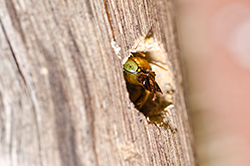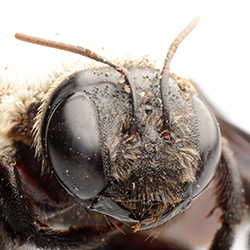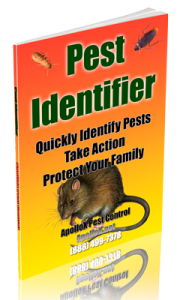Carpenter Bee Control – How do you know you have carpenter bees?
 If you see a solitary bee hovering in the vicinity of an unfinished wood structure, it’s possible that bee is a carpenter bee. Does the bee dart at you? It’s likely the carpenter bee male, attempting to protect his territory. It will be a half inch to an inch long with a thick body and a shiny, hairless abdomen.
If you see a solitary bee hovering in the vicinity of an unfinished wood structure, it’s possible that bee is a carpenter bee. Does the bee dart at you? It’s likely the carpenter bee male, attempting to protect his territory. It will be a half inch to an inch long with a thick body and a shiny, hairless abdomen.
Inspect the area where you notice the bee most. Is there evidence of sawdust? If so, you’re very close to the carpenter bee’s home. Now look for a small, nearly perfectly round hole a little smaller than the size of a dime. It will look like it was professionally drilled into the wood. Watch more closely and you might see one solitary bee entering and exiting the hole. Chances are you’ve discovered the carpenter bee’s home.
Carpenter bees drill their home into a wooden structure, then stock it with food (pollen) and lay their eggs on the food. The eggs hatch, larvae emerge, consume the food, and continue to develop into the next generation of carpenter bees. Unlike termites and powderpost beetles, carpenter bees do not eat wood.
 Carpenter Bee Control – Where do carpenter bees most love to drill their home?
Carpenter Bee Control – Where do carpenter bees most love to drill their home?
Carpenter bees love unfinished, unprotected wood. Likely places are an unfinished wooden fence on your property, a wooden play structure, a deck that perhaps was finished a few years ago, but is due for re-finishing due to exposed bare wood.
Carpenter Bee Control – How do you prevent carpenter bees?
The best carpenter bee prevention is a good paint job. Carpenter bees are unlikely to drill through a couple good coats of paint. If the area has not been painted recently and is wearing, exposing bare wood, it’s time to repaint. For best results, use an oil based or polyurethane paint. Remove any severely damaged wood and replace it with chemical pressure-treated wood.
Carpenter Bee Control – What problems can they cause?
 Carpenter bees are generally non-aggressive. Only the female can sting, and then only when handled. The biggest problem is the hole the bee has drilled into the wooden structure. The next generation of carpenter bees will expand that hole, digging deeper into the wood. Each hole leaves more wood exposed to the elements and potentially to other wood boring insects.
Carpenter bees are generally non-aggressive. Only the female can sting, and then only when handled. The biggest problem is the hole the bee has drilled into the wooden structure. The next generation of carpenter bees will expand that hole, digging deeper into the wood. Each hole leaves more wood exposed to the elements and potentially to other wood boring insects.
Worse yet, if there are woodpeckers nearby, they love to eat the larvae of carpenter bees. To get to the larvae, they’ll drill a much larger hole in the wood, creating a lot more damage.
Even if there are no woodpeckers, carpenter bee droppings can discolor the wood immediately below the entrance to their hole. And, the buzzing insect can be annoying to people who don’t understand what it is, and may confuse it with a wasp. Children may try to pick it up in which case, if it’s the female, they could be stung.
Carpenter Bee Control – How do you rid your property of carpenter bees?
You could purchase a pesticide dust from your local hardware store. Be sure to carefully read and observe the safety precautions to avoid exposure to the toxic chemical. Place the proper amount of dust into the entrance of the carpenter bee hole. Leave the hole unsealed so that the carpenter bee continues to freely enter and exit the hole, getting the dust on its body. After a week, seal the hole with wood filler and repaint the area.
Carpenter Bee Control – Why not seal and paint the active nest?
Carpenter Bee Control – Get professional help.
There are a few drawbacks to the above DIY method of carpenter bee control:
- Exposure to toxic chemicals.
- Ineffective application.
- Failure to locate all the carpenter bee nests on your property.
- Sealing and painting over an active carpenter bee nest.
- Desire to avoid the trouble of all the steps necessary to completely eliminate carpenter bees.
If you’re concerned about any of these drawbacks give us a call:
ApolloX Pest Control
(888) 499-7378
We’ll quickly and safely eliminate all carpenter bees from your property, and help you to prevent carpenter bees in the future.













Recent Comments